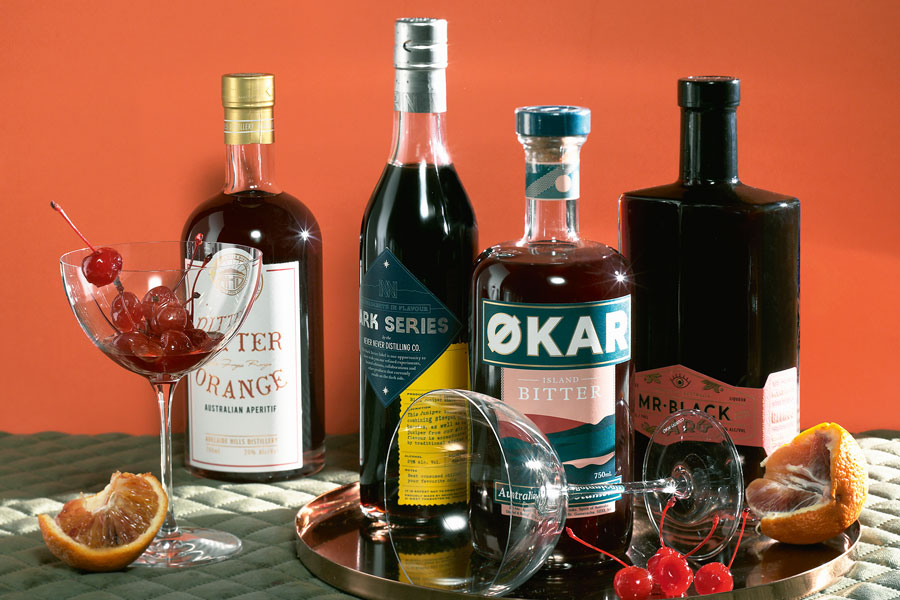Bittersweet, complex and delicious, amaro is a spirit as diverse and fascinating as anything in the wide world of drinks. Though ubiquitous in Western Europe, here in Australia, amaro is often left to gather dust on the shelf at the neighbourhood trattoria, its intricate flavours and utility as a digestif after a carb-heavy meal lost to time. But now, thanks to a boom in craft distilleries, local producers are reviving amaro with new flavours and native Australian ingredients, giving this ancient spirit a fresh identity.
The name amaro comes from the Latin word amarum, meaning bitter, and refers to a variety of traditional European bittersweet herbal liqueurs. Flavoured with all manner of herbs, spices, fruits and vegetables, there is a huge range of styles and some incredibly complex flavours. Like all liqueurs, amaro is sweetened with sugar, but it sets itself apart with natural bittering agents such as wormwood, gentian, angelica and citrus peel. Infusing alcohol with bitter herbs is a method of preserving wine that dates back thousands of years, as many bitter plants also have preservative properties. During the Middle Ages, when spirits became popular in Europe, they were often used as medicine. Unique styles arose in different areas based on locally available ingredients, and these styles eventually became hundreds of brands, which remain a fundamental part of the drinking culture in Europe.
While Campari is easily the most famous traditional amaro, the range of styles is immense, from light, fruity and barely bitter Aperol to the intensely herbaceous and astringent Fernet- Branca. And while the medicinal properties may no longer be cutting-edge science, anyone who’s sipped on a Montenegro or Averna after over-indulging in pasta can attest to amaro’s near-magical effects on digestion. This interest in amaro comes at a time when Australia’s domestic distilling industry is booming, riding a global wave of interest in craft spirits, particularly gin and whisky. As local varieties steadily gain ground on imported labels, producers are beginning to look beyond the popular choices to lesser-known spirits such as amaro.
“Australia is well-placed to make amaro because many of the native foods that grow here tend to be quite tart and bitter,” says Sacha La Forgia, the founder of Adelaide Hills Distillery, which produces Bitter Orange, a blend akin to Campari. “Our amaro is based on a recipe passed on to me by my mentor in northern Italy, near where Campari is made. I took that recipe and subbed in Australian native ingredients, so it’s reminiscent of a classic Italian amaro but still very much Australian.”

Pop your head into any of the longstanding Italian joints on Lygon Street in Melbourne’s Inner North and you’ll see all the classic amari lined up on the backbar, ready to ease the stomachs of enthusiastic carbophiles. But modern Italian restaurants such as Tipo 00 are also encouraging a younger generation of Melburnian foodies to appreciate these spirits.
Luke Skidmore, the owner of Tipo 00, says amaro is still a fundamental part of a good Italian meal. “It’s such a unique and interesting drink to finish on,” he says. “Pretty much everyone we give it to is amazed by how good it is, and it’s so stylistically varied that you can always find one that every customer is going to love. But it’s not something Australians are familiar with, so it’s fun to introduce them. I’ve got mates who are now bringing bottles of amaro to parties instead of wine or beer.”
Many Australian distillers have deep ties to the hospitality industry, especially in Melbourne, the epicentre of our Italian food culture. This is where the love of coffee influences our choice of cocktails (espresso martini, anyone?), which in turn influences spirits producers. And it all adds up to a renewed appreciation of amaro. Sean Baxter spent years working as a cocktail bartender in Melbourne before moving to Adelaide to found Never Never Distilling Co., which produces some of Australia’s (and the world’s) best traditional gins. In late 2019, Baxter teamed up with Black Pearl, one of Melbourne’s most respected cocktail bars, to produce a juniper- based amaro as part of his label’s Dark Series experimental releases. With the Never Never production team’s wine industry experience and advice from the liqueur maker Marionette, “it was an amazing combination of ideas and personalities”, says Shay Chamberlain, the manager of Black Pearl.
Australia’s craft distilleries are ripe for this sort of experimentation. Mostly small, flexible and independently owned, they’re free to play around with small- batch products and off-the-wall recipes that the big international companies would be loath to attempt. It’s this spirit of innovation and collaboration between the different aspects of the drinks industry that makes Australian spirits such an exciting category. If it results in a greater range of delicious local amari, that’s something to feel pretty sweet about.
